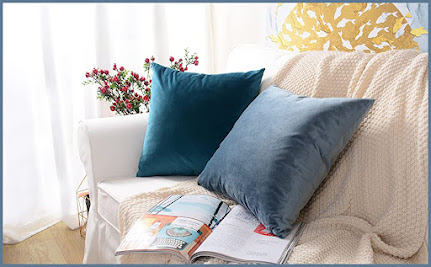Featured
- Get link
- X
- Other Apps
Learn How to Mix and Match Throw Pillows
Throw pillows are one of the simplest ways to add style to your living room, family room, or bedroom. And, with so many gorgeous, affordable pillows on the market, it's a shame to limit yourself to just two or three solid-coloured pillows—or, worse, the set that came with your couch.
The first thing to keep in mind is that your pillows do not need to match. If they do not, you can achieve a more professional, fashionable appearance. If you're not confident in your ability to select pillows, the following suggestions will help you mix and match new patterns and/or colours, allowing you to rapidly refresh your room with a coordinated but not matchy-matchy look.
There are numerous ways to mix and match throw pillows, and, indeed, it can sometimes take a trained eye. It is possible, however, for a room to look wonderfully polished and modern even if no single pillow matches another in colour, pattern, or style.
If you don't have the time or willingness to experiment or shop extensively, the Rule of Three is an excellent rule for guiding your decisions and simplifying the process.
Choose Three Colors
First, decide on a "colour narrative" to guide your cushion choices. Use three different colours from various sources in the room, such as the wall colour, the carpeting, your bedding, or the curtains. If you use a range of pillows in different designs, the look will be coherent if they all have the same colours.
Choose Three Patterns
You can also combine three distinct patterns as long as each design involves at least one of the colours in the three-colour tale you've chosen. It's frequently easier to start with your "lead" design, which is usually the largest and contains all three colours in your colour narrative. The secondary patterns you choose can then only use one or two of the colours. Working backwards, selecting a lead design from pillows you already own, is much more challenging.
Choose Three Pattern Sizes
When applying the Rule of Three, it is critical to consider the scale of your patterns because you do not want your patterns to compete with one another. Choose patterns in three distinct scales instead, allowing one pattern to dominate.
The largest design in the group should be your lead pattern, followed by a medium-sized print, such as a stripe or small houndstooth. The third design should therefore be the most modest, such as a solid colour with an intriguing texture, a dotted swiss, or one with a weak tone-on-tone pattern, such as a damask stripe.
Break the Rules if You Want
Now that you've learned the Rule of Three, we should point out that all rules are intended to be broken—especially when it comes to design! If you begin mixing and matching your selection of magnificent throw pillows according to the method provided here, only to discover that four colours work better for you, or that you prefer two large patterns over one, that's fine. Finally, it's only crucial that you enjoy what you see, so utilise this Rule of Three as a starting point for inspiration. If you stick to the formula, you'll get stylish results, but don't be afraid to experiment until you find the mix that works for you.
Additional Tips
Once you master the Rule of Threes, also consider these other principles used by room designers:
· Odd numbers seem modern: When arranging your throw pillows, bear in mind that odd numbers work best for a modern design—think three or five. In most design tastes, odd numbers are more artful, and a smaller number of larger cushions looks fresher than a tangle of smaller ones.
· Even numbers seem traditional: An even number of comparable pillows, such as two or four, looks clean and ordered for a balanced and symmetrical look, especially on your bed or couch.
· When shopping for throw pillows, think about the fill and how it will affect the appearance. For example, a feather-and-down fill has greater "give" and a softer squish. Foam and other synthetic fillers are firmer and, in general, less expensive. These pillows will keep their shape better but will not seem as opulent.
· Mix textures, as well as patterns and colours: Pattern and colour mixing, are crucial, but texture should not be disregarded. Experiment with the contrast of smooth and rough, soft and fuzzy. Consider faux fur and velvet, as well as linen, knit wools, and tasselled embellishments. You can get creative with touch and sensation if you keep your colour and pattern theme throughout the play.
- Get link
- X
- Other Apps
Popular Posts
TIPS TO MIX AND MATCH YOUR PILLOWS LIKE A PRO
- Get link
- X
- Other Apps
Expert Tips for Mastering the Art of Mixing and Matching Pillows
- Get link
- X
- Other Apps



Comments
Post a Comment